Featured Comment:
“WOW! this is amazing! At first I was overwhelmed, but it came together so well! I used bacon (no pork belly anywhere to be found in the town where I live), and the cut was not as thin as I hoped for, but I think the cornstarch helped keep everything together. 6 perfect pork covered rice balls…and I will make this again! Thank you for such a wonderful and (deceptively) easy-to-make recipe!”
– Charissa
What is Nikumaki Onigiri?
Nikumaki Onigiri (肉巻きおにぎり) is a type of rice ball that is wrapped in thinly sliced pork instead of the traditional nori seaweed and then fried with a soy-sauce-based sauce to give it a savory flavor.
This variation of onigiri might not be well-known outside of Japan, but it is quite popular within the country.
The most appealing thing about this dish is its addictive flavor and unique texture, which sets it apart from any other variation of onigiri. It is a very satisfying dish that is definitely worth trying!
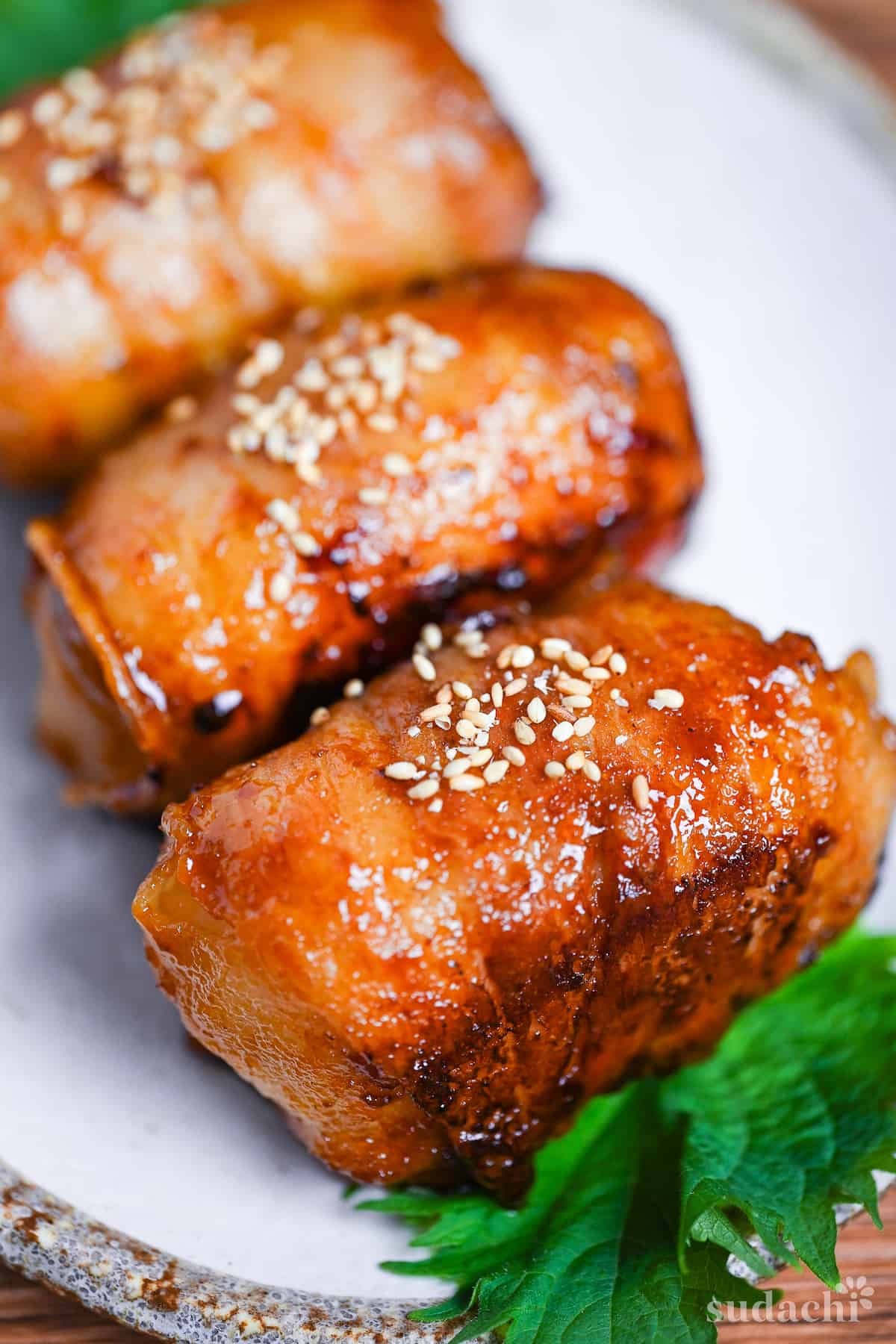

How I Developed This Recipe
All the recipes I share on my blog are ones I have developed, cooked, and then thoroughly enjoyed myself. However, this particular recipe was so good it became an instant favorite and I couldn’t wait to share it!
The thing about this dish lies in its teriyaki-style flavor, complemented by garlic and pork wrappers, which are made to be as crispy as possible.
It’s a simple dish with a slight junky feel, but sometimes such a dish can fill your heart. Please give it a try!
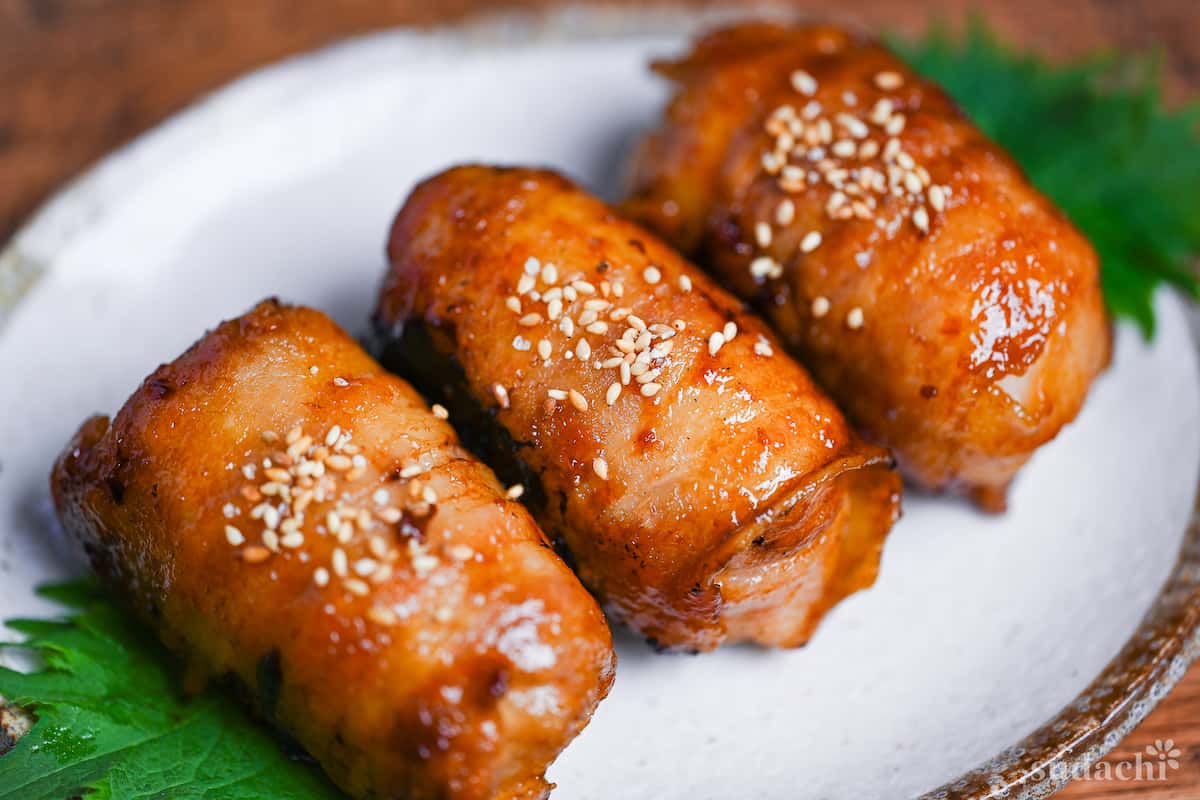
Ingredients & Substitution Ideas
- Thinly Sliced Pork: While any thinly sliced part works, I recommend pork belly for its rich flavor and crispy texture. Try and use long pieces for easy wrapping.
- Cooked Japanese Short-Grain Rice: The sticky texture of Japanese rice is essential for rice balls. Find specific recommendations for brands available in the U.S. detailed in the How to Cook Japanese Rice Recipe.
- Cornstarch: Coating the pork in a thin layer of starch not only crisps up the surface and improves the overall texture and flavor, but also aids in thickening the sauce. Potato starch can be used as an alternative.
- Sesame Oil: Adds a nuanced flavor to marinades.
- Sake: Beverage-grade, unsalted sake is ideal for its clean taste. Cooking sake can be used if you adjust the dish’s saltiness accordingly. A ‘Sake 101‘ article can offer more insights.
- Soy Sauce: For soy sauce brand recommendations, refer to my soy sauce guide.
- Mirin: Go for Hon Mirin if possible.
- Sugar: Regular sugar that you normally use is perfectly fine.
- Ginger & Garlic Paste: While grating fresh ginger and garlic offers the best flavor, store-bought pastes are convenient alternatives.
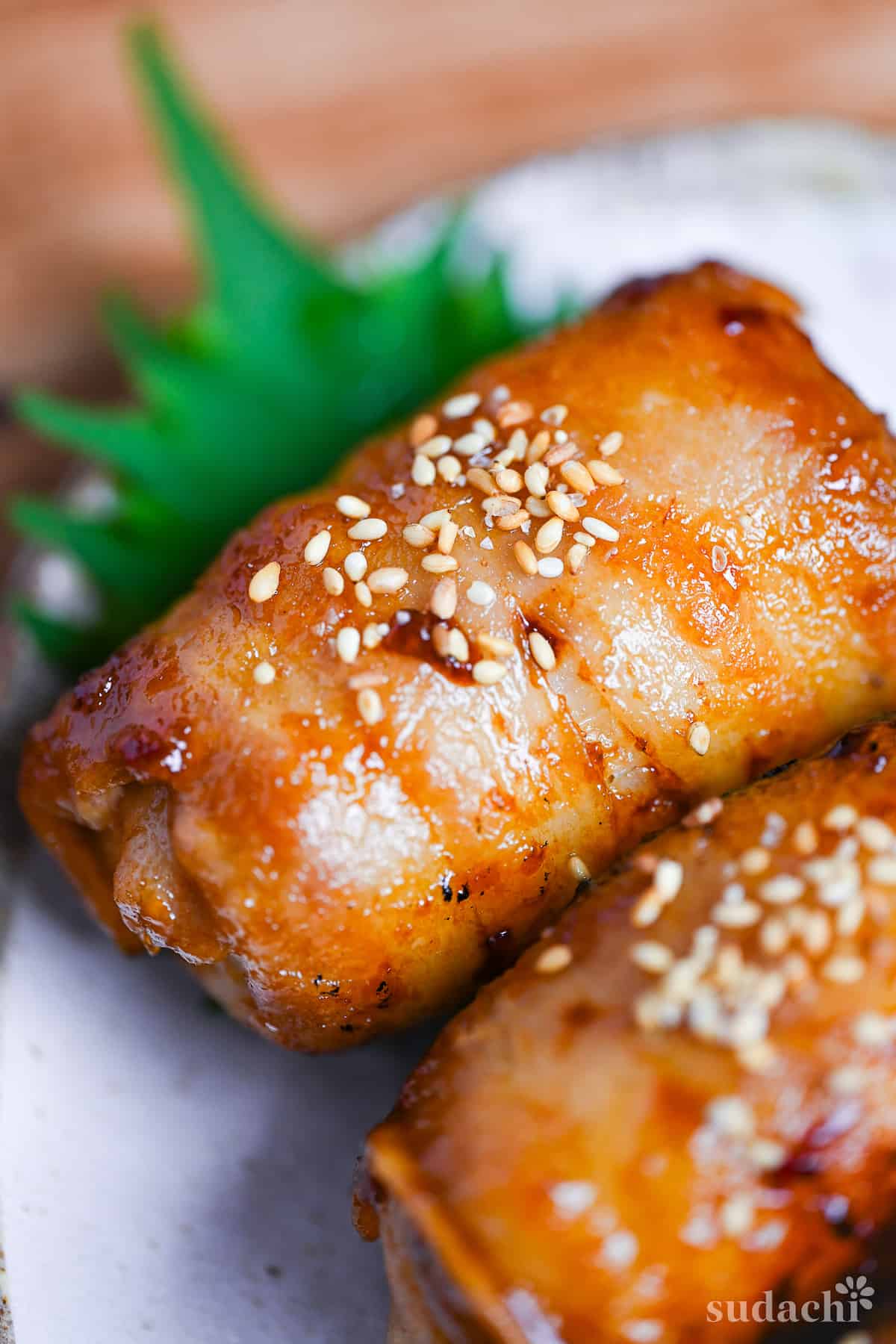
Visual Walkthrough & Tips
Here are my step-by-step instructions for how to make Nikumaki Onigiri at home. For ingredient quantities and simplified instructions, scroll down for the Printable Recipe Card below.
Start by dividing cooked Japanese rice into six equal portions, each weighing about 50g. Shape each portion into compact bales, making sure they’re firm enough to hold their shape.
Tip: Wet your hands before handling rice to prevent sticking and be careful not to press too hard and crush the rice.
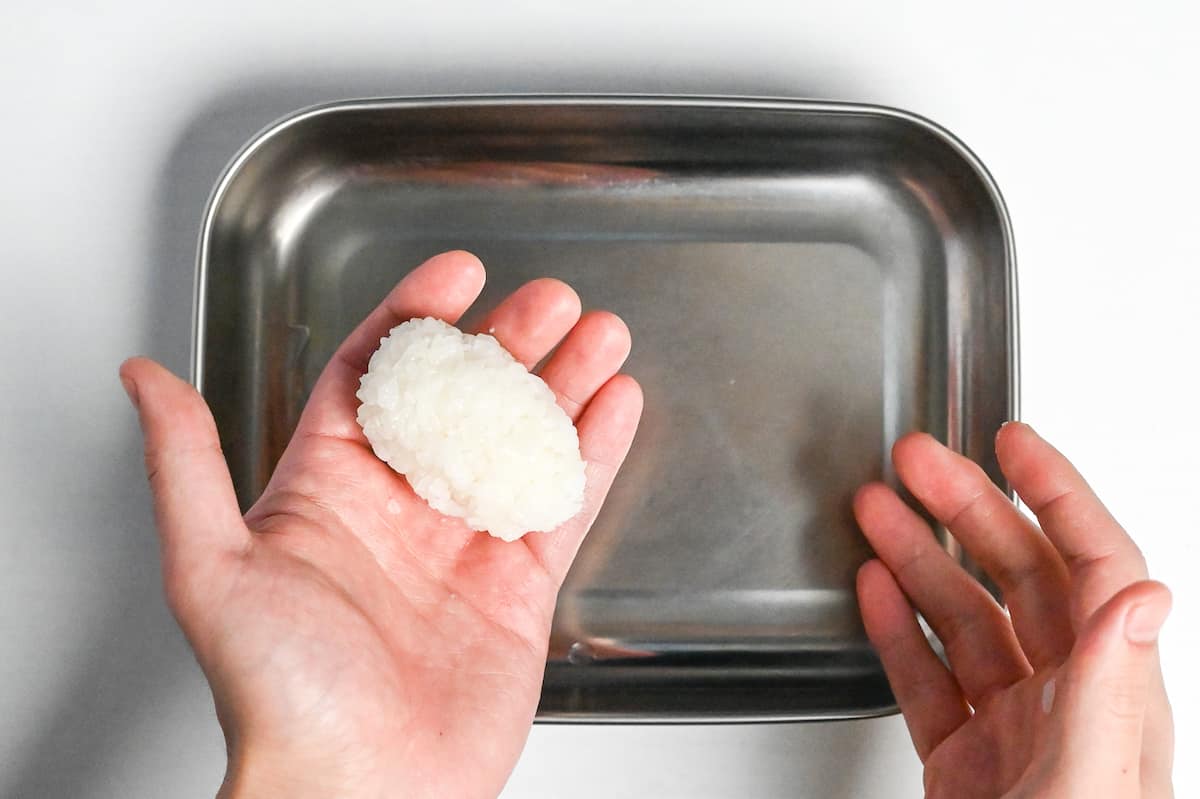
Next, take a slice of pork and wrap it around the rice ball lengthwise for a snug fit.
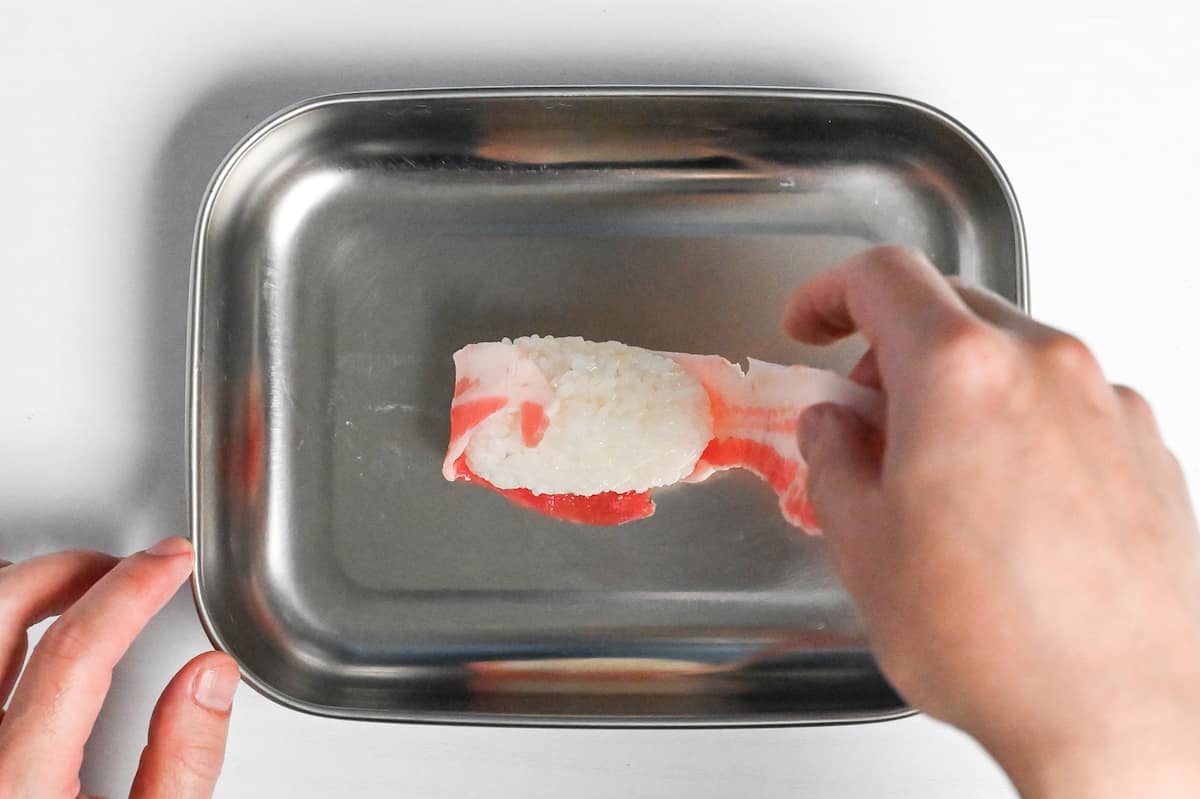
Use a second slice of pork to wrap in the opposite direction, ensuring complete coverage of the rice.
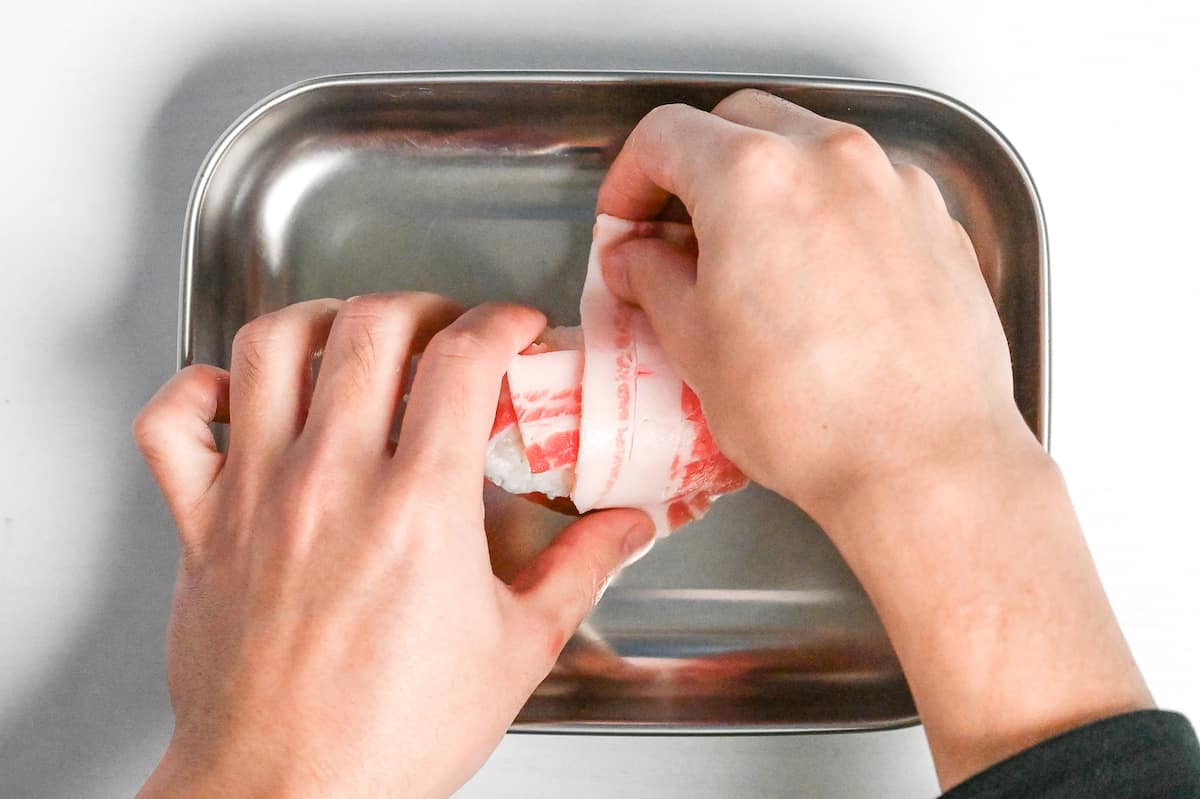
Trim any excess pork that extends beyond the rice to avoid overlap; these trimmings can be used for other rice balls.
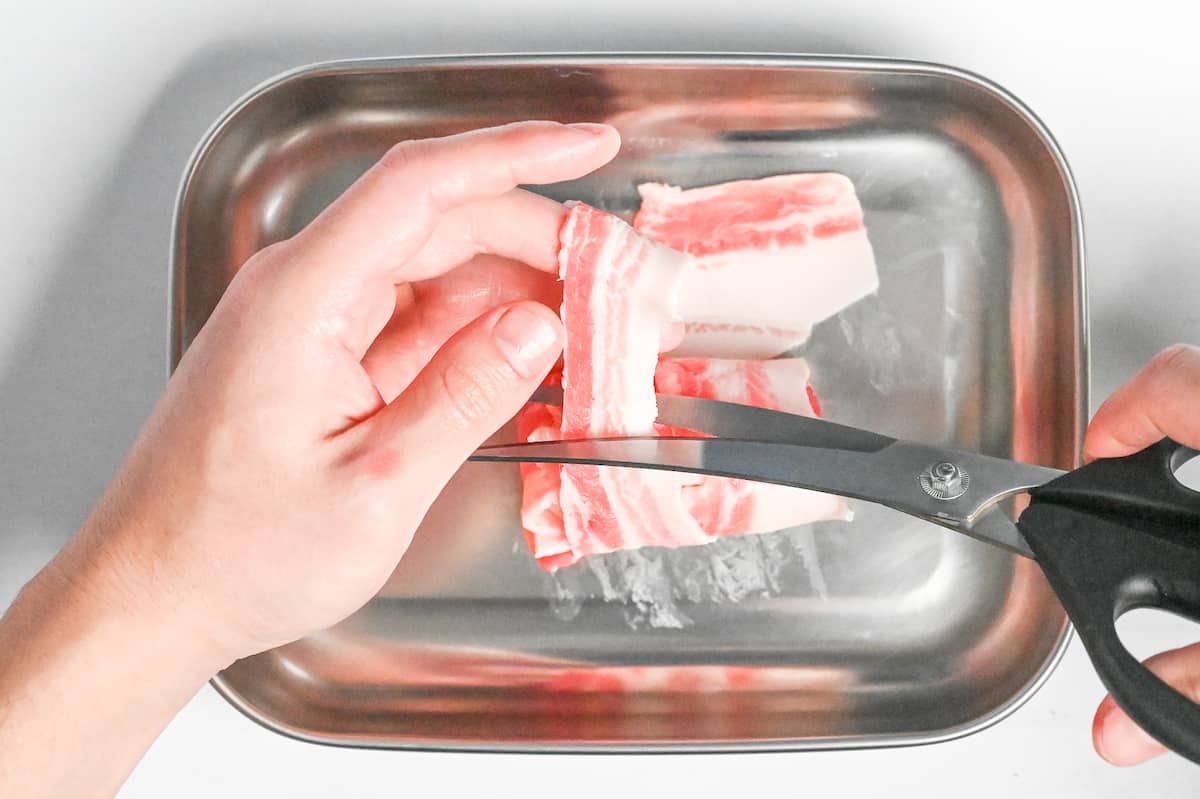
The goal here is a tight wrap that fully encases the rice.
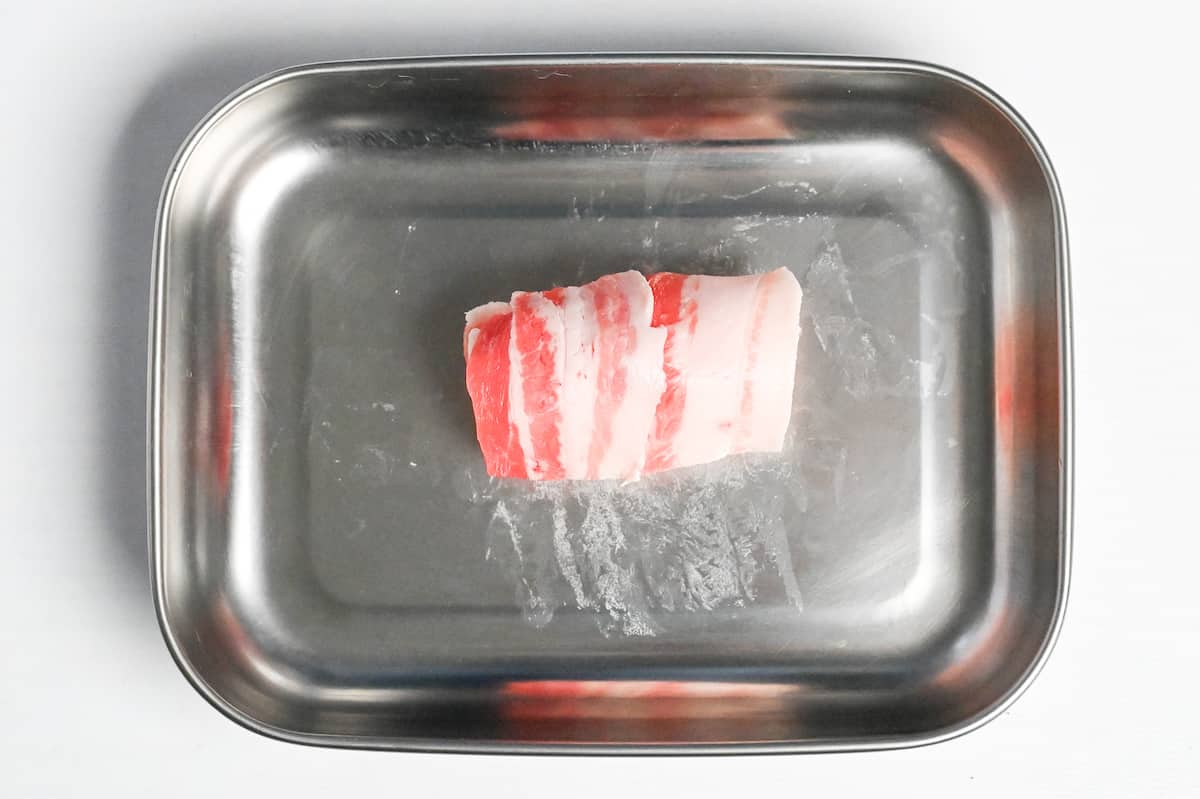
Once wrapped, lightly coat each rice ball with cornstarch. Lay out some cornstarch on a plate and roll the pork-wrapped rice in it until evenly coated. This step helps to create a crispy exterior when fried.
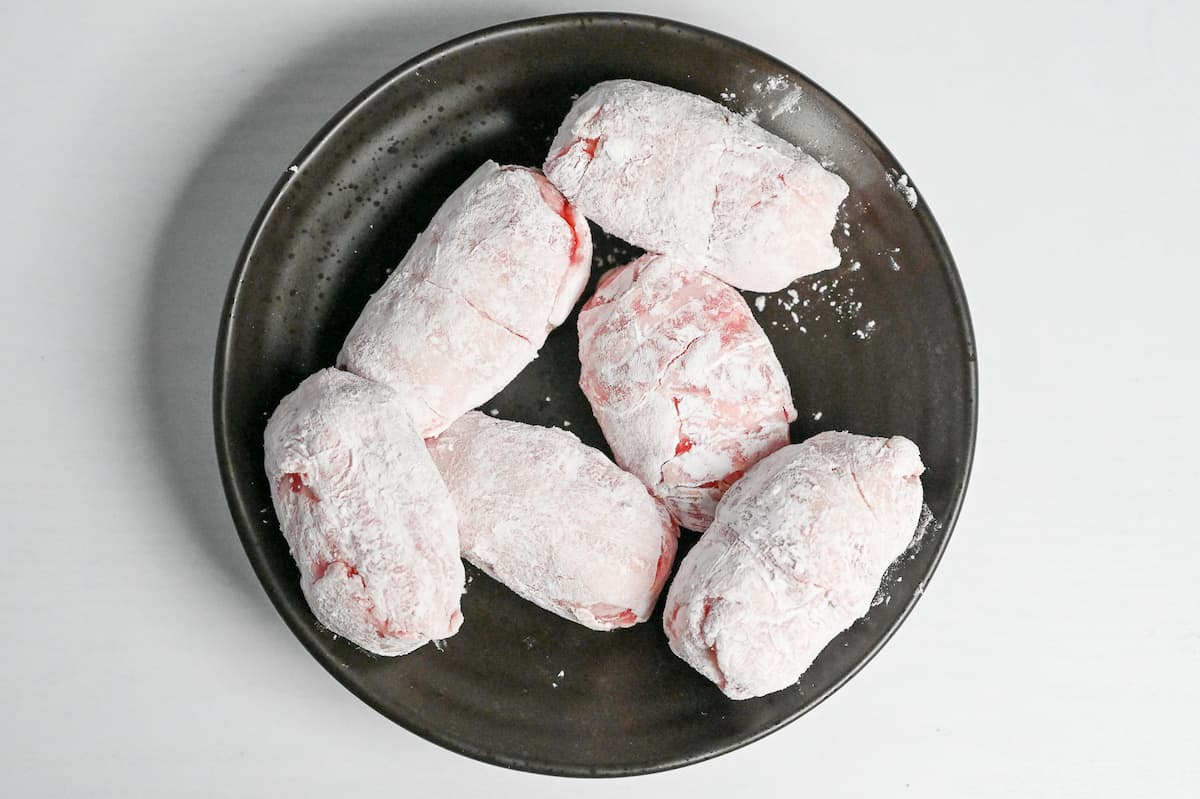
Heat sesame oil in a large frying pan over medium heat. Gently place the rice balls in the pan and fry, turning occasionally, until golden brown and crispy on all sides.
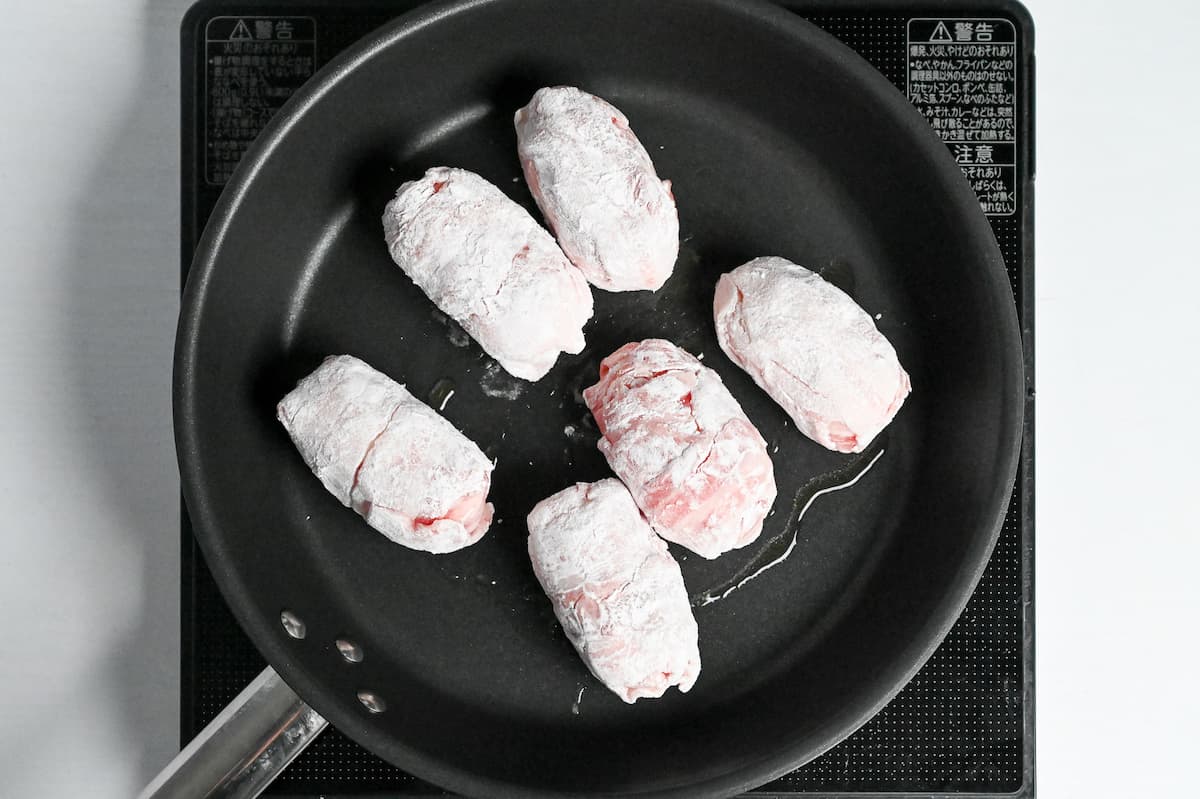
This is where the magic happens, transforming the pork into a crispy shell around the soft rice.
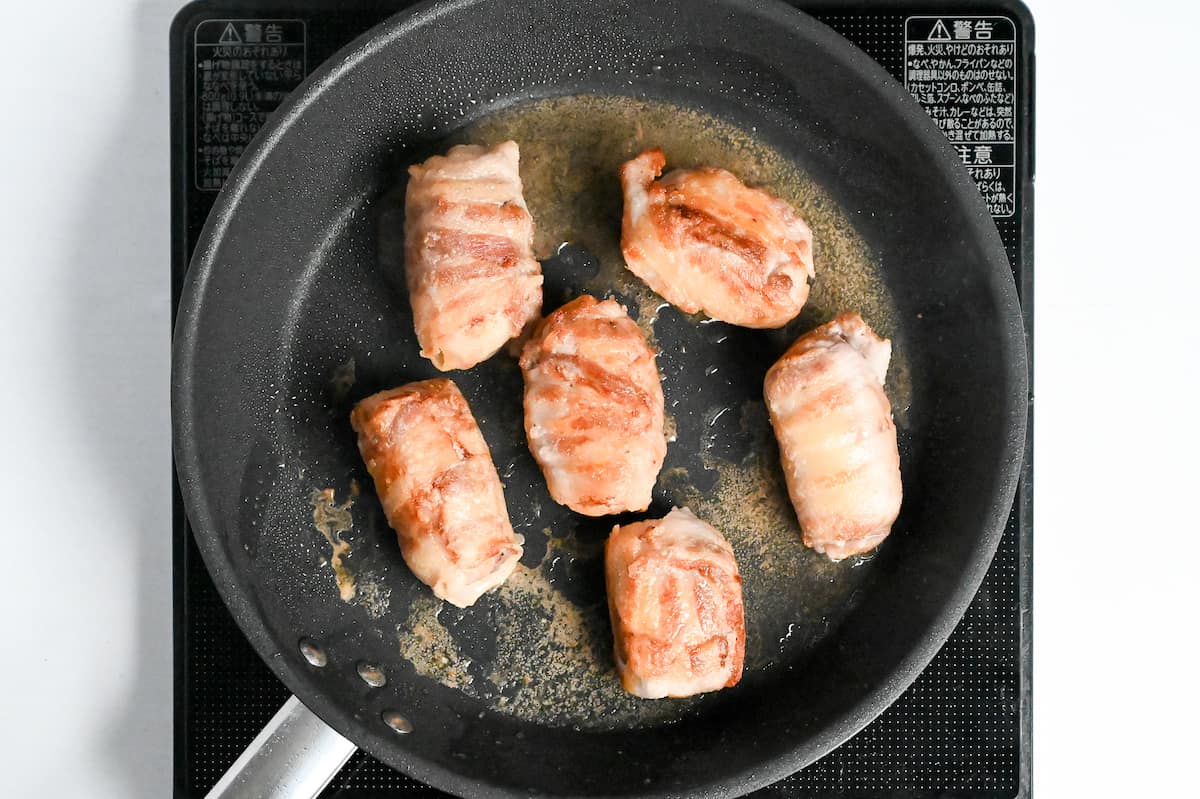
While the rice balls are frying, mix together sake, soy sauce, mirin, sugar, ginger, and garlic in a bowl.
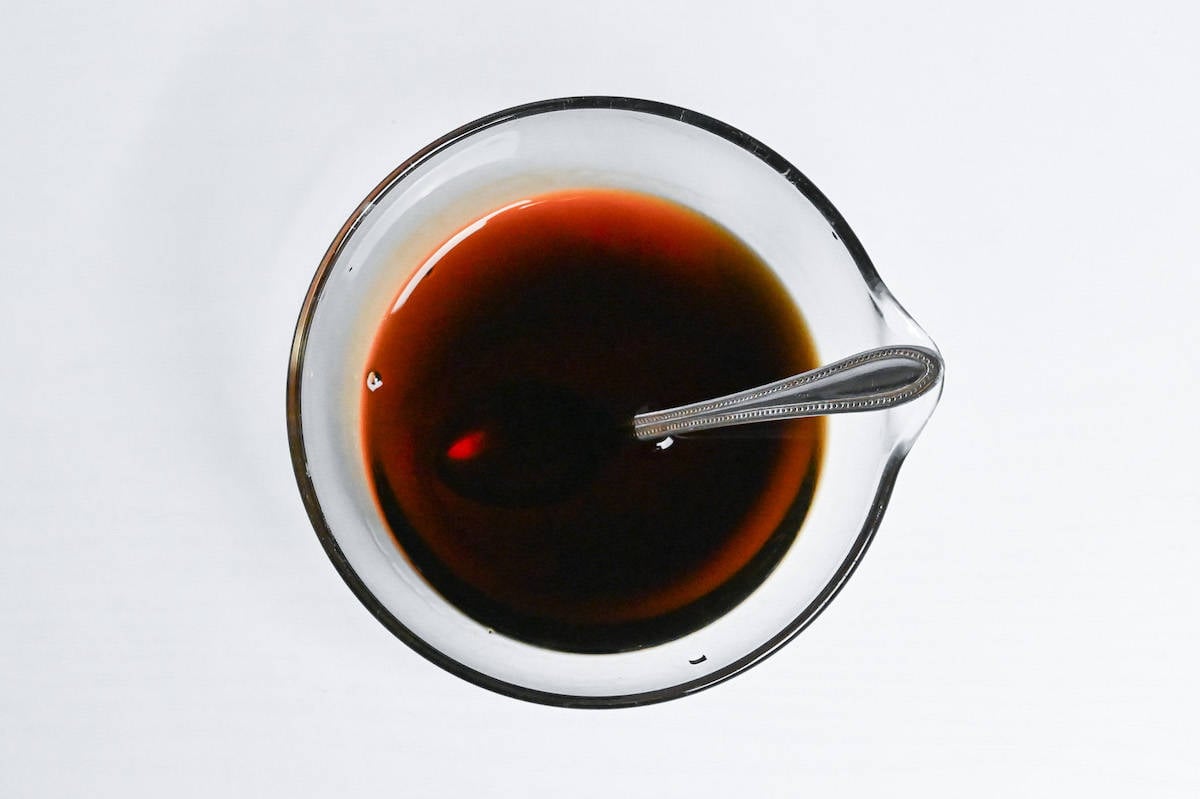
After the rice balls are crispy, wipe any excess oil from the pan using kitchen paper. Then, crank up the heat to high and add the sauce. Cook, turning the rice balls to ensure they’re evenly coated until the sauce reduces to a thick glaze.
Turn regularly to prevent burning and lower the heat if you feel its thickening too quickly.
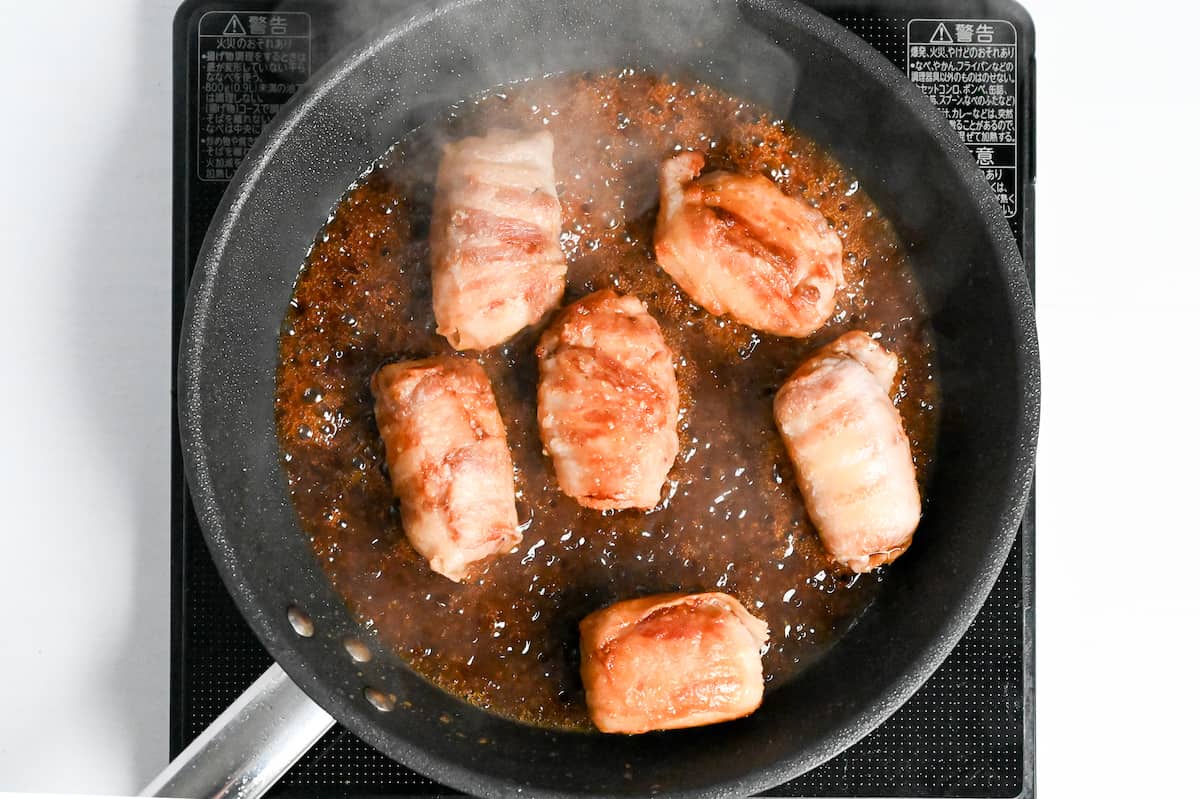
Sprinkle sesame seeds over the glazed rice balls for a crunchy texture and a nutty taste. For a final touch, wrap each rice ball in a shiso leaf (optional). Not only does this add a burst of color and freshness, but it also makes them easier to handle and eat.
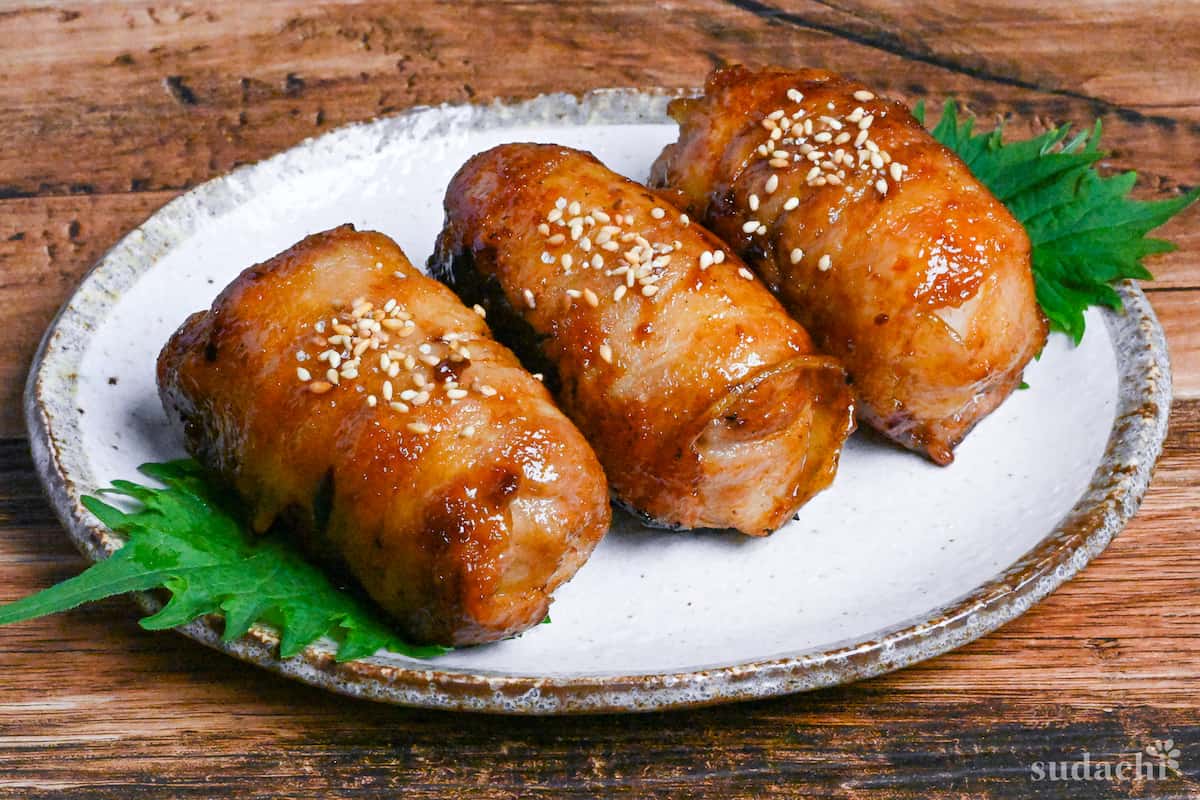
How to Store
To enjoy nikumaki at their best, I recommend eating them straight away. Avoid storing and reheating since this will cause the texture of both the rice and pork to deteriorate.
If you are taking them in a lunch box, store in a cooler bag with an ice pack and eat them as soon as possible.
Best eaten the same day.
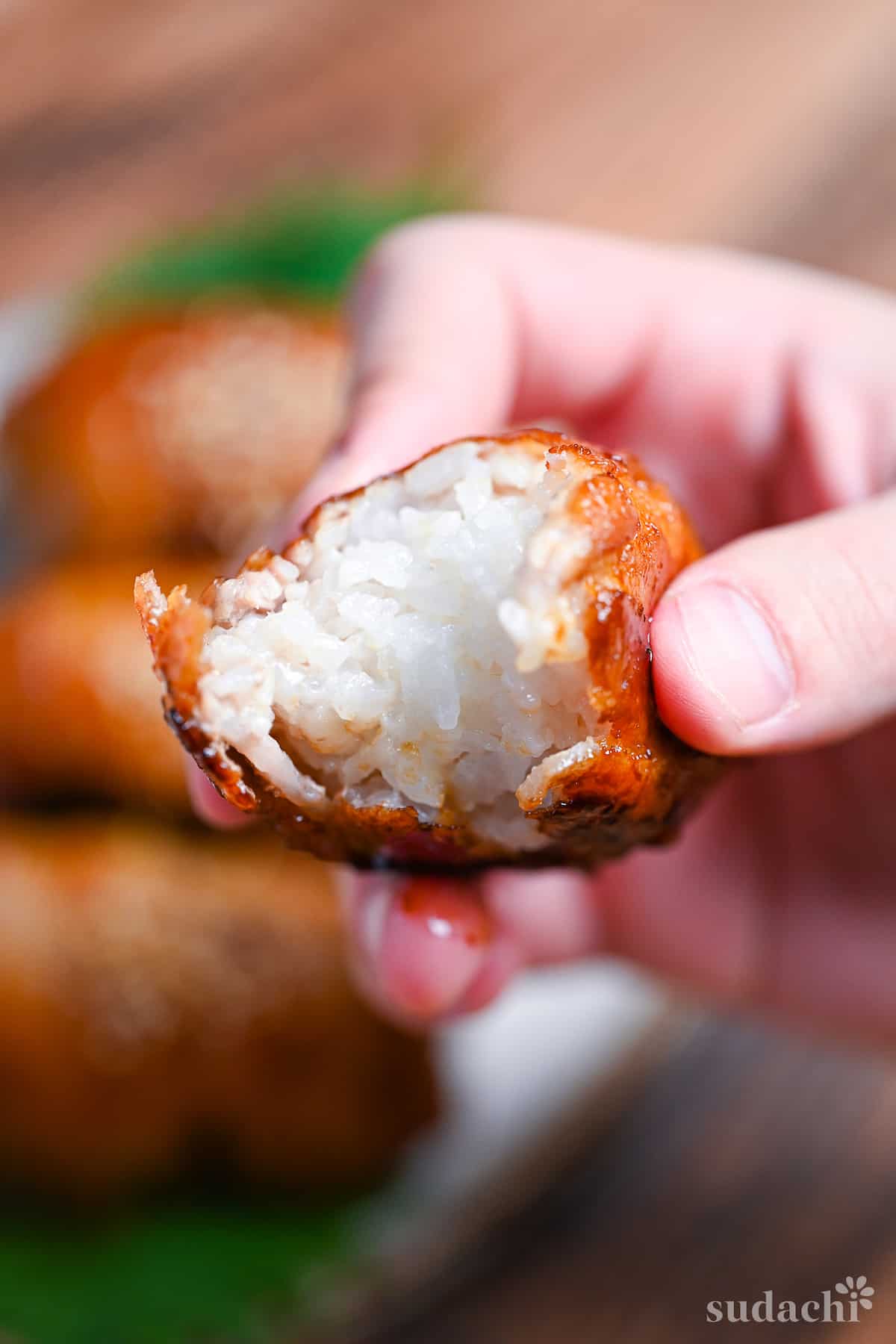
I hope you enjoy this Nikumaki Onigiri recipe! If you try it out, I’d really appreciate it if you could spare a moment to let me know what you thought by giving a review and star rating in the comments below. It’s also helpful to share any adjustments you made to the recipe with our other readers. Thank you!
More Onigiri Recipes

Pork-Wrapped Rice Balls (Nikumaki Onigiri)
Ingredients
- 300 g cooked Japanese short-grain rice 50g / ⅓ cup per rice ball
- 9 slices thinly sliced pork belly (approx 12 inches/30cm) 1 ½ slices per rice ball
- 1 tbsp cornstarch
- ½ tbsp cooking oil
- 3 tbsp Japanese soy sauce (koikuchi shoyu)
- 3 tbsp sake
- 2 tbsp mirin
- 1 tbsp sugar
- 1 tsp grated ginger root or ginger paste
- 1 tsp grated garlic or garlic paste
- 1 tsp toasted white sesame seeds (optional)
- 6 perilla leaves (shiso) optional
My recommended brands of ingredients and seasonings can be found in my Japanese pantry guide.
Can’t find certain Japanese ingredients? See my substitution guide here.
Instructions
- Divide 300 g cooked Japanese short-grain rice into 50g pieces (approx 1/3 cup). Wet your hands and shape each portion into a barrel shape. Press the rice firmly enough to hold its shape but be careful not to crush the rice.

- Wrap the barrel lengthways with one slice of pork belly and trim the excess with scissors.

- Wrap the excess and one half of another slice in the other direction until the rice is completely covered. Each rice ball should use 1 and a half 12 inch pieces of pork belly.

- Dust a plate with 1 tbsp cornstarch and coat each pork-wrapped rice ball with a thin layer. Dust off any excess before adding them to the pan.

- Heat a large frying pan on medium and add ½ tbsp cooking oil. Place the rice balls in the pan and fry. Turn occasionally until golden and lightly crispy all over.

- While you wait, take a small bowl and mix 3 tbsp Japanese soy sauce (koikuchi shoyu), 3 tbsp sake, 2 tbsp mirin, 1 tbsp sugar, 1 tsp grated ginger root and 1 tsp grated garlic.

- Once the pork is crispy and cooked through, use kitchen paper to wipe up the excess oil in the pan.

- Increase the heat to high and pour the sauce into the pan. Turn the rice balls frequently until coated in sauce. Once the sauce has thickened and the rice balls are fully covered, remove the pan from the heat.

- Sprinkle the top with 1 tsp toasted white sesame seeds and wrap each rice ball with a perilla leaf. Enjoy!

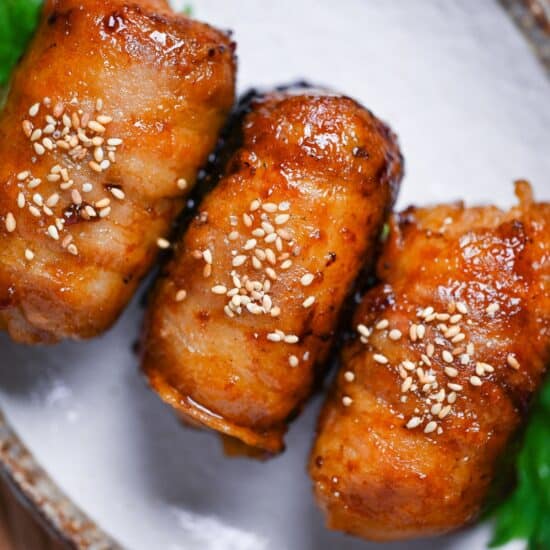


WOW! this is amazing! At first I was overwhelmed, but it came together so well! I used bacon (no pork belly anywhere to be found in the town where I live), and the cut was not as thin as I hoped for, but I think the cornstarch helped keep everything together. 6 perfect pork covered rice balls…and I will make this again! Thank you for such a wonderful and (deceptively) easy-to-make recipe!
Hi Charissa,
Thank you so much for trying this recipe and sharing your success! You did an amazing job with wrapping rice with bacon! They look absolutely perfect! It’s wonderful to hear that everything came together so well for you. This is exactly why I love sharing these recipes! I appreciate you taking the time to let me know how it turned out, and I’m so happy that you’ll be making them again!
Yuto